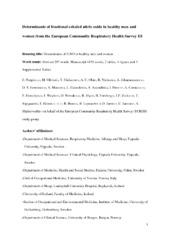Determinants of fractional exhaled nitric oxide in healthy men and women from the European Community Respiratory Health Survey III
Nerpin, Elisabet; Olivieri, Mario; Gislason, Thorainn; Olin, Anna C.; Nielsen, Rune; Johannessen, Ane; Ferreira, Diogenes S.; Marcon, Alessandro; Cazzoletti, Lucia; Accordini, Simone; Pin, Isabelle; Corsico, Angelo; Demoly, Pascal; Weyler, Joost; Nowak, Dennis; Jõgi, Rain; Forsberg, Bertil; Zock, Jan P.; Sigsgaard, Torben; Heinric, Joachim; Bono, Roberto; Leynaert, Bénédicte; Jarvis, Deborah; Janson, Christer; Malinovschi, Anderi
Peer reviewed, Journal article
Accepted version
Permanent lenke
https://hdl.handle.net/1956/22967Utgivelsesdato
2019Metadata
Vis full innførselSamlinger
Originalversjon
https://doi.org/10.1111/cea.13394Sammendrag
Introduction: The fractional exhaled nitric oxide (FENO ) is a marker for type 2 inflammation used in diagnostics and management of asthma. In order to use FENO as a reliable biomarker, it is important to investigate factors that influence FENO in healthy individuals. Men have higher levels of FENO than women, but it is unclear whether determinants of FENO differ by sex. Objective: To identify determinants of FENO in men and women without lung diseases. Method: Fractional exhaled nitric oxide was validly measured in 3881 healthy subjects that had answered the main questionnaire of the European Community Respiratory Health Survey III without airways or lung disease. Results: Exhaled NO levels were 21.3% higher in men compared with women P < 0.001. Being in the upper age quartile (60.3‐67.6 years), men had 19.2 ppb (95% CI : 18.3, 20.2) higher FENO than subjects in the lowest age quartile (39.7‐48.3 years) P = 0.02. Women in the two highest age quartiles (54.6‐60.2 and 60.3‐67.6 years) had 15.4 ppb (14.7, 16.2), P = 0.03 and 16.4 ppb (15.6, 17.1), P = <0.001 higher FENO , compared with the lowest age quartile. Height was related to 8% higher FENO level in men (P < 0.001) and 5% higher FENO levels in women (P = 0.008). Men who smoked had 37% lower FENO levels and women had 30% lower levels compared with never‐smokers (P < 0.001 for both). Men and women sensitized to both grass and perennial allergens had higher FENO levels compared with non‐sensitized subjects 26% and 29%, P < 0.001 for both. Conclusion and Clinical Relevance: Fractional exhaled nitric oxide levels were higher in men than women. Similar effects of current smoking, height, and IgE sensitization were found in both sexes. FENO started increasing at lower age in women than in men, suggesting that interpretation of FENO levels in adults aged over 50 years should take into account age and sex.
